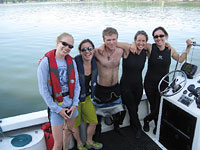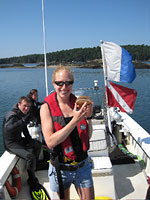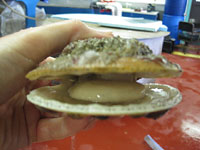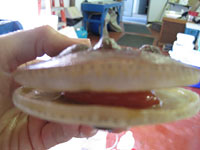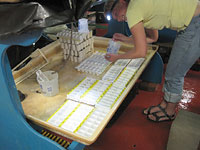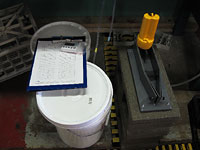

 | |||||||||||||||||||||||
|
|
Journals 2009/2010Jennifer Emblidge
August 14, 2009 Today, I began my work at 8:30 a.m. loading the Wahle lab boat with dive gear. Charlene, Noah, Lee, Katherine and I were going out to collect scallops for the scallop spawning experiments they are running. We were leaving at this hour in order to dive during low tide, which was at 10:30 a.m. this morning. Once the boat was loaded we motored down the Damariscotta River until we made it to a location that was known to have scallops. Scallops are normally found at depths greater than 30 feet on muddy bottoms. The divers this morning were Noah, Lee, and Katherine and Charlene and I were boat support personnel. They ended up going on two dives that were around 40 feet for about 30 minutes. They brought up a total of 70 scallops.
These scallop experiments are another activity going on in the Wahle lab. Giant sea scallops are the Northeast's most bountiful single species fisheries. However, the scallop fishery in Maine has been depleted to the point that closures have been used in order to allow the fishery to rebound and increase in population size. Scallops are a free spawning species. This means that both the males and the females release their gametes into the open water where external fertilization occurs. The Wahle lab wants to examine if this type of reproduction makes scallops vulnerable to population depletion. It is hypothesized that increased distance from a spawning male will decrease egg fertilization success. They have proposed to look at the effects in the population dynamics of free spawning species with low population densities. One thought is that when free spawners are located very close together, their fertilization success will increase. The scallop population density in Maine has reached less than one per a ten meter squared area. Fisheries management is key to the survival of the scallop fishery, but a successful management technique is still not well understood. The Wahle lab is interested in evaluating different management technique. In particular, they are interested in evaluating why scallop fishery closures have increased the biomass of the scallop population.
We returned from scallop collecting around noon. Our first order of business was to find tank space for the scallops in the lab and divide them into male and female tanks. This was to prevent any unexpected early fertilization. After the scallops were placed happily into their new homes, I started to help Jana with her lobster experiments.
Jana Deppermann is from Germany visiting the Wahle lab this summer. She arrived about a week ago and will remain in the lab carrying out her experiments for about five more weeks. At that time she will be moving to work with another lab at the Woods Hole Oceanographic Institute (WHOI) in Cape Cod. Jana is working towards her Ph.D. in biology though the University of Oldenburg in Germany. She is studying the population structure of the American lobster in the Gulf of Maine. There are many different components to Jana's research. Here in the Wahle lab, she is performing genetic studies for the hatchery project. This work will help to determine the success of the hatchery by determining which of the lobster samples are hatchery raised and which ones are from the wild. The Wahle lab performs regular sample collections at the release areas in Penobscot Bay. I will be participating in this event next week so I will wait to describe it in detail now. Jana is also examining the reasons behind why the lobster population in the northern part of the Gulf of Maine is different from the southern population. She is running behavior experiments in order to answer this question. This afternoon, I helped Jana set-up some experiment related to the areas of her work I previously described. My job was to separate out to surviving stage 1 lobster larva and place them into individual well otherwise known as ice cube trays. We picked up this stage 1 larva from the hatchery two days ago. A large percentage of the larva did not survive the journey from Stonington to the lab in Walpole. The results of my lobster larva sorting are shown in the picture below. The larva will be used to set up two different experiments. For the first one, Jana will be exposing half of the larva to water that has been in a container with sand and rocks. Next, she will be preserving tissue samples of those that have and have not been exposed. She will be preserving the sample to bring them back to Germany for genetic work. Jana will be looking to see if there is a difference in the RNA of those larva that were exposed to the sandy water when compared to those that were not exposed. Lobsters are highly dependent on their sense of smell. One idea is that perhaps lobster larvae use their sense of smell in order to determine where they settle. This would help to explain the difference between the lobsters in the northern and southern part of Maine. Jana will be examining the two groups of larvae in for developmental changes that should be seen in their RNA sequences.
Jana will be using the remainder of the stage 1 larvae to set up a behavior experiment that will be used to examine if larva can determine the difference between water that has been exposed to a rocky bottom and water that has not. She places the larva into a special set-up that she designed. The unit will have water flowing through it. After the larva is placed into the unit, it will be able to choose one of two different paths. One path will have water that was exposed to a rocky bottom flowing through it and the other path will have regular filtered seawater flowing through it. This experiment will be used to help determine if lobster larva can use their sense of smell to help determine where to settle on the ocean bottom. I asked Jana what was the most surprising outcome of her research that she has found so far. She responded that she was shocked to find that she was able to distinguish between lobster sites that are located as little as 30 km away. She found that lobster from the two sites were genetically different. She also found that lobsters have the ability to recognize their neighbors and in fact, they prefer neighboring lobsters to others during settlement and recruitment. This may also help explain why lobsters from the northern Gulf of Maine are different from those in the south. |
||||||||||||||||||||||
